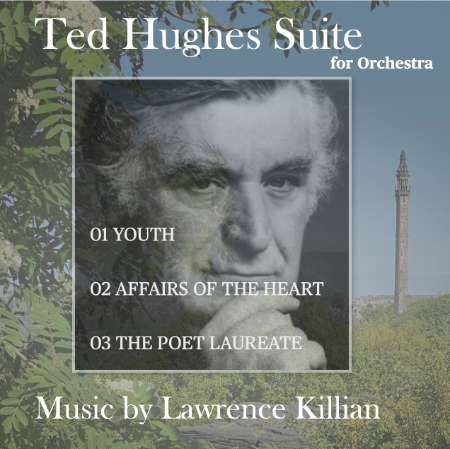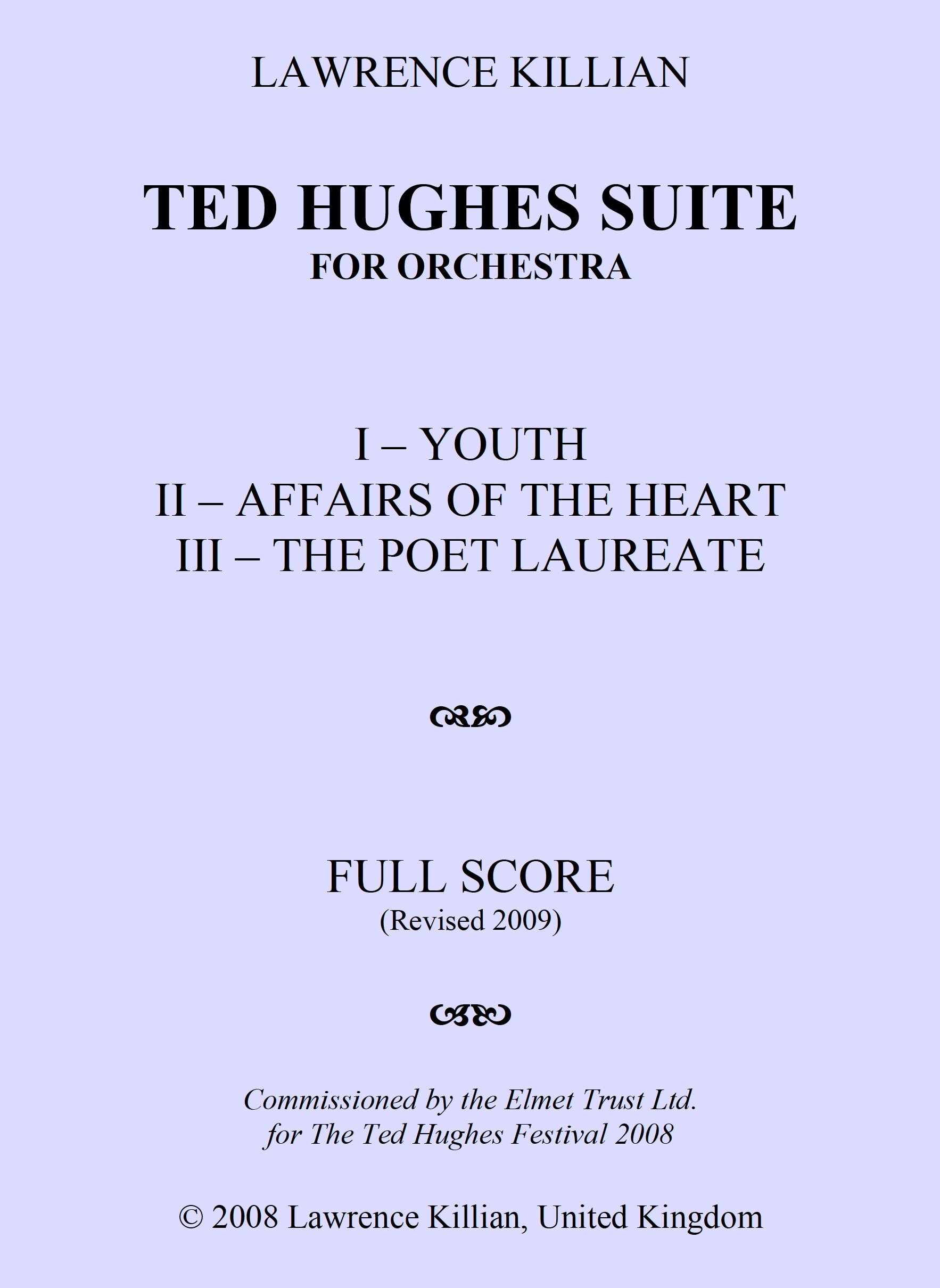Ted Hughes Suite for Orchestra
Ted Hughes Suite
1. Youth (5’ 30”)
2. Affairs of the Heart (6’ 30”)
3. The Poet Laureate (5’ 10”)
SCORING: 2+1,2+1,2,2: 4,3,3,1: Timps (x3), 2 Perc, Harp (Opt.) and Strings (Full details in score)
DURATION: Approx. 18 minutes
AVAILABILITY: Orchestral Set for Hire from the Light Music Society, or from Lawrence Killian
Commissioned by the Elmet Trust to mark the 10th anniversary of the death of Ted Hughes in 1998, the Ted Hughes Suite is programmatic in nature and depicts key elements of the life of the poet Ted Hughes. The premier took place as part of the Ted Hughes Festival in 2008 and was performed by the Todmorden Symphony Orchestra under their conductor Nick Concannon Hodges.
PROGRAMME NOTE
I – YOUTH
The opening music depicts the spaciousness and openness of the moors around Mytholmroyd in West Yorkshire, England, where Ted Hughes lived as a child. The scene is set with echoes of birdsong, bubbling springs, and the clear wind blowing in gusts across the landscape. There are points of interest in every dip and at every crest. Birds, foxes, rabbits, sheep and other wildlife present a wonderful opportunity for adventure to the quickening mind.
Suddenly this image is broken by the sound of Red Indian drums in the distance, inviting attendance at the camp in the woods below. The pace quickens as the trek begins. Up and down, in and out, tumbling at times; through the valleys, through the woods, over the walls and onwards towards the sound of drums.
The day is Sunday, the chapel is full, a hymn tune is heard being played from within the stone walls. Outside the sun shines warmly and crickets can be heard inside the cracks in the stone walls around and about. The excitement of the adventure ever-present, ever enticing, the youngster and his friends are keen to get back to the woods and to their adventures. What a wonderful place this is!
II – AFFAIRS OF THE HEART
Let’s begin.... excitement, passion, joy, children, then tragedy, overwhelming grief, utter devastation, numbness. A memory renewed, a passion re-kindled, the love of nature shines through the darkness, the way forward is set.
III – THE POET LAUREATE
The opening of the finale represents a feeling of well-being and nostalgia; great recognition is dawning. The Queen’s Gold Medal for Poetry, fishing trips, and Ted’s second marriage set the scene.
A royal fanfare and tribute signal the arrival of the new Poet Laureate for the nation and form a brief transition into the dance-like finale of this suite. A positive celebration of the legacy left to us now. A final short coda takes us back to the magic of youth and the wonders of nature.
My grateful thanks to Donald, Eric, and Lesley of the Elmet Trust for their inspiration, shared memories, and encouragement to make this music relevant to the task set. Thanks also to Nick Hodges and the Todmorden Orchestra who gave the first performance and went away smiling after the first rehearsal!
My thanks also to my friends in the Orchestra of Square Chapel Halifax who gave the third public performance to celebrate my 50th Birthday on 21 June 2009.
Lawrence Killian, Halifax, UK, September 2009
CONCERT PERFORMANCES/ REVIEW
18 October 2009: Autumn Concert
Peel Hall, University of Salford U.K.
Salford Symphony Orchestra
Conducted by Barrie McKinnon
21 June 2009: “Maestro’s Favourites”
Square Chapel Centre for the Arts, Halifax U.K.
Orchestra of Square Chapel
Conducted by Lawrence Killian
08 November 2008: Autumn Concert
Todmorden Town Hall, Todmorden U.K.
Todmorden Symphony Orchestra
Conducted by Nicholas Concannon Hodges
28 October 2008: The Ted Hughes Festival
World Premiere, Calder High School, Mytholmroyd U.K.
Todmorden Symphony Orchestra
Conducted by Nicholas Concannon Hodges
REVIEW - Concert 08 November 2008
The Ted Hughes Suite by Lawrence Killian, the orchestra's first trumpet, struck me as much more instantly successful and noticeably gripped the affections of the audience. Killian studied with Arthur Butterworth in Skipton and George Odam in Bath. His Three Lands suite was played at last year's Tod Proms concert as was Reeman's Beside the Seaside.
The tripartite Hughes suite began with His Youth in which an idyllic summery haze and the sweet rasp of bird-song give way to a lush Ravel-like consonance and an unruly impressionist outburst recalling Frank Bridge's Enter Spring.
His Loves was almost too public in its celebratory extroversion soon offering intimations of the skull beneath the face. An incongruous but utterly enjoyable flouncy soft-shoe shuffle sweeps us into a Fred Astaire and Ginger Rogers dance in the long and honourable lineage of British light music.
Finally came the deeply impressive Poet Laureate movement with a strongly memorable tune, splendid Waltonian irruptions, rumba percussion and a flourish that brought a smile to the face.
This music deserves wide currency. I hope that it receives its due. BBC Radio 3, Classic Fm, ASV Sanctuary, Avie and Naxos really should pay this work some heed. Do not let this superb music slip away.
Rob Barnett, November 2008



